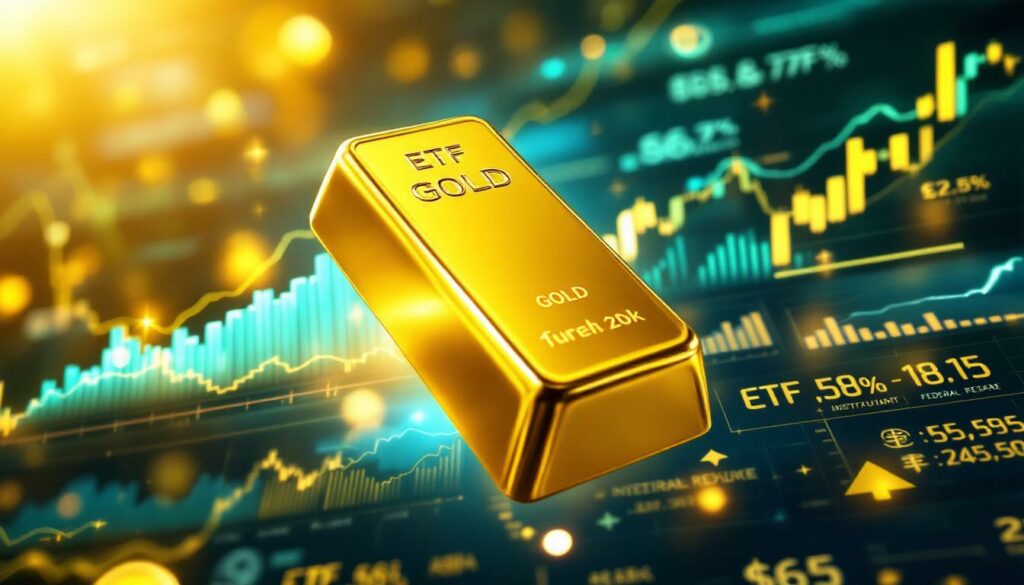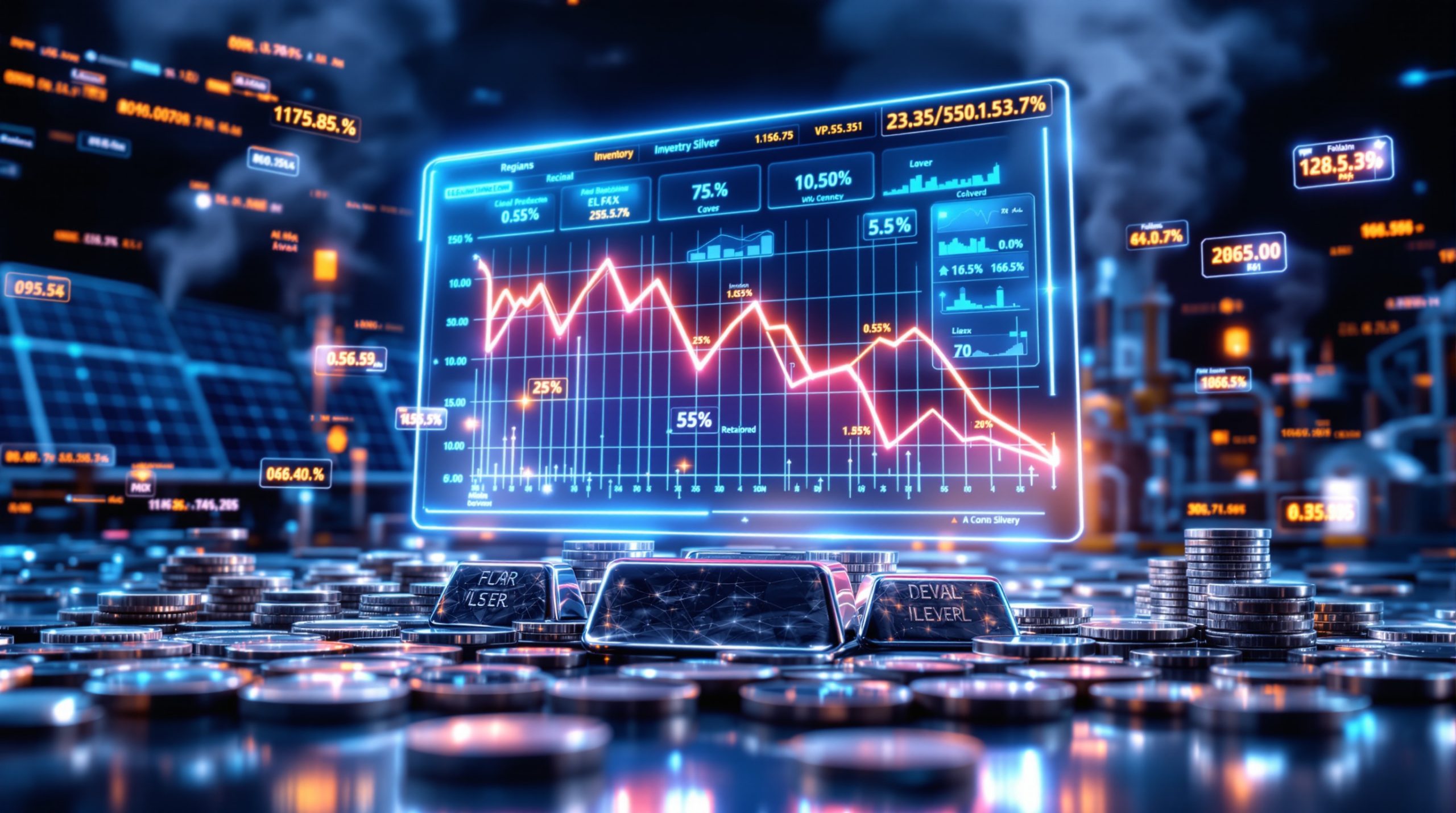What's Driving the Recent Surge in Gold Investment?
Gold has witnessed a remarkable resurgence in institutional interest, with substantial capital flowing into the precious metal as investors seek stability amid market uncertainty. This renewed enthusiasm reflects both tactical positioning and strategic portfolio adjustments in response to evolving gold market trends.
Unprecedented ETF Inflows Signal Institutional Shift
Gold-backed ETFs have experienced their largest semi-annual inflow since early 2020, with 397 metric tons (valued at nearly $38 billion) added in just six months of 2023-2024. This substantial capital movement represents a significant shift in institutional investor sentiment toward physical gold as a strategic asset.
"The physically backed gold ETFs just posted their largest semiannual inflow since the early pandemic panic of early 2020," notes Joseph Cavatoni of the World Gold Council. "Nearly 400 metric tons added in just 6 months—it's over $38 billion in capital."
The scale of these inflows demonstrates renewed confidence in gold's role as a portfolio stabilizer during periods of market uncertainty. Unlike previous gold rallies, this movement appears driven by institutional conviction rather than speculative positioning.
Market Risk and Geopolitical Uncertainty
Current market conditions feature heightened volatility, unpredictable price movements, and growing concerns about global economic stability. Investors are increasingly recognizing gold's historical performance during systemic market drawdowns.
"Volatility is up, price gapping down is a significant risk," explains Cavatoni. "People are basically looking at their portfolio and saying it's time for that safe haven role that gold plays."
What's particularly compelling is gold's track record during market turbulence. "Gold over the last 14 instances of significant market corrections has performed exceptionally well," Cavatoni observes. "The 6 months trailing that, gold's performed even better." This consistent pattern of resilience during downturns has strengthened gold's appeal as a strategic gold investment.
Market Insight: During the March 2020 COVID-19 market crash, while equities experienced drawdowns of 30-35%, gold initially dipped but recovered rapidly, ending the year up 25%. This pattern of resilience during extreme volatility continues to attract institutional capital.
Monetary Policy Expectations
While anticipation of interest rate cuts may not be the primary driver currently, it remains a significant factor on investors' radar. The potential shift in Federal Reserve leadership and monetary policy direction is creating additional incentives for institutional investors to secure gold positions.
"Everyone's focused on that rate cut cycle and when that's going to happen," states Cavatoni. "Jerome Powell's term ends in 2026, and there's questions about who will be running the Fed and the kind of policies they'll implement."
This forward-looking perspective represents a shift from reactive to proactive positioning, with institutions accumulating gold ahead of anticipated policy changes rather than responding after announcements.
How Are Regional Investment Patterns Evolving?
The gold market is experiencing distinct regional trends, with notable differences between Western institutional flows and emerging patterns in Asian markets.
US Funds Lead While Asia Gains Momentum
US-based funds have dominated in absolute terms, but Asian markets are demonstrating remarkable growth relative to their global assets under management. Asian investors contributed 104 tons (28% of net flows) despite representing only 9% of global gold AUM.
"Asia bought 104 tons, 28% of net flows and 9% of global assets under management," Cavatoni highlights. This disproportionate participation signals a structural shift in how Asian investors approach gold market trends.
China's Evolving Investment Landscape
China has emerged as a particularly active market, with Cavatoni noting that "China as an example has seen significant flows… actually has been the lion's share of the flows in Asia." In April 2023, Chinese inflows exceeded all other regions including the US, underscoring the market's growing importance.
This surge reflects fundamental changes in China's investment ecosystem:
- Government authorization for insurance companies to pilot gold investment programs
- Domestic institutions developing sophisticated allocation strategies with "gold as a component of a portfolio as much as 20% allocations"
- Expansion of retail access through bank-offered gold accumulation plans
- Growing financial market sophistication driving diversification away from traditional property and equity investments
"There's a shift away from basically using jewelry as that store of value and actually a growth of the investment markets, particularly in China and India," explains Cavatoni, highlighting the transition from physical ownership to financial products.
Jewelry Demand Recalibration
The record-high price environment has created a temporary slowdown in jewelry demand across traditional gold-consuming markets. Fabricators are reducing inventory levels in response to price sensitivity, though this adjustment hasn't yet significantly impacted recycling volumes.
This shift represents a rebalancing between investment and consumption demand rather than an overall reduction in market interest. As Cavatoni notes, "In the retail space, bar and coin demand in the West is on hold, but those institutional channels are still very active."
What's Behind Central Bank Gold Acquisition Strategies?
Central banks have emerged as consistent and significant buyers in the gold market, reflecting a fundamental reassessment of gold's role in national reserves.
Persistent Official Sector Buying
Central banks have maintained consistent gold purchases for eight consecutive months, continuing a multi-year trend of reserve diversification. "Central banks are buying for eight straight months," confirms Cavatoni, highlighting the persistence of this trend despite price appreciation.
The World Gold Council's annual central bank survey reveals that nearly half of respondents (73 central banks – the highest number ever recorded) signal intentions to increase their gold allocations, up dramatically from 29% in the previous year.
"In our annual central bank survey, 73 of the central banks… are signaling that they're going to increase their allocation of gold. That's up from 29% the year before," Cavatoni reports. This marked shift in intentions suggests the central bank buying trend has substantial runway ahead.
Strategic Motivations Beyond Price Considerations
Central banks are prioritizing gold's strategic benefits over price sensitivity. As Cavatoni explains, "They're looking at what it does when you add it: safety in terms of an asset that performs in crisis, liquidity to access that asset when things come under pressure, homegrown inflation in their markets, and diversification."
These motivations represent a multi-faceted approach to reserve management:
- Safety during crisis periods: Gold's proven performance during financial turbulence
- Liquidity assurance: Maintaining access to convertible assets when markets seize
- Inflation protection: Hedging against persistent inflationary pressures
- Fiat currency diversification: Reducing dependence on dollar-denominated assets
Technical Note: Central banks typically acquire gold through direct market purchases, bilateral transactions with other central banks, or domestic production purchases. These transactions are often conducted discreetly to minimize market impact, though they are eventually reported to the IMF.
Structural Shift in Reserve Management
"Gold surpassed the euro in terms of a reserve asset," notes Cavatoni, marking a significant milestone in the evolution of the international monetary system. This transition reflects deeper concerns about traditional reserve currencies and signals a fundamental reassessment of gold's role in national financial security frameworks.
The shift appears durable rather than cyclical, with central banks continuing purchases even as prices have appreciated substantially. "They're still adding at these prices," Cavatoni emphasizes, suggesting conviction in gold's long-term strategic value beyond near-term price considerations.
How Are Institutional Investment Strategies Evolving?
Institutional approaches to gold allocation are becoming more sophisticated, with deeper integration into portfolio construction and risk management frameworks.
Beyond Traditional Allocation Models
Institutional conversations around gold allocation are becoming more sophisticated, with discussions moving beyond the conventional 1-2% portfolio allocation. "The conversations with pension funds and others are no longer about 1-2%, they're about 5-10%," reveals Cavatoni.
This expanded allocation reflects growing recognition of gold's unique properties in a portfolio context, particularly as traditional diversification approaches face challenges. The high correlation between bonds and equities in recent market cycles has prompted a reevaluation of alternative diversifiers.
Strategic vs. Speculative Positioning
While short-term price volatility continues to attract speculative capital, the price stability above $3,000 per ounce indicates strong support from strategic long-term investors. "The fact that the price is being held up well above that $3,000 price point is giving us a signal that strategic investors aren't selling," observes Cavatoni.
This foundation of patient capital provides a solid floor for the market despite day-to-day fluctuations. "Strategic investors aren't selling. They're actually looking at slow and constant allocation to gold," adds Cavatoni, highlighting the distinction between tactical traders and long-term holders.
Physical Metal Implications
The substantial ETF inflows represent physical metal being secured in allocated storage, effectively removing it from circulation. As Cavatoni explains, "When a physically backed ETF buys, that's physical metal that's going into vaults and taken off the market."
While current volumes haven't created significant market tightness, the cumulative effect of continued institutional demand could eventually impact physical market dynamics, particularly if combined with sustained central bank purchases.
What Are the Key Catalysts and Risks for Gold in 2025?
Looking ahead, several factors could influence gold's trajectory, with potential catalysts appearing more numerous than downside risks in the current environment.
Potential Upside Catalysts
-
Monetary policy shifts: Federal Reserve transitioning to a rate-cutting cycle. "Everyone's focused on that rate cut cycle and when that's going to happen," notes Cavatoni.
-
Leadership changes: Potential new Fed chairperson appointment as Powell's term approaches conclusion in 2026. "Jerome Powell's term ends in 2026, and there's questions about who will be running the Fed," Cavatoni points out.
-
Persistent geopolitical tensions: Ongoing global conflicts and trade disputes continue to support safe-haven demand.
-
Inflation concerns: Resurgent price pressures despite central bank efforts remain a concern for many institutional investors.
These catalysts could work individually or in combination to further strengthen gold's appeal as both a tactical and strategic holding.
Downside Risk Assessment
Identifying specific factors that could significantly pressure gold prices remains challenging in the current environment. "It's hard to put your finger on one thing that's going to cause the floor to drop out of gold," admits Cavatoni.
Potential risks include:
-
Viable alternative safe havens: Though cryptocurrency and stablecoins don't currently present immediate substitution threats. "I don't think there's anything that is going to displace gold in terms of its usage as a safe haven," asserts Cavatoni.
-
Prolonged jewelry demand weakness: Extended consumer resistance to higher price levels could eventually impact market balance.
-
Unexpected central bank selling: Though survey data suggests this is highly unlikely. "It's hard to put your finger on one thing that's going to cause a central bank to sell in large-scale ways," notes Cavatoni.
Mining Sector Outlook
Gold producers are responding to higher prices with measured optimism, maintaining approximately 2% annual production growth. The junior mining sector is showing renewed confidence compared to recent years, with exploration activity increasing.
Current price levels provide substantial operating margins for efficient producers, though cost inflation in energy, labor, and equipment continues to impact the sector. This balanced supply response suggests limited downside risk from production surges.
How Is Retail Investment Behavior Changing?
Retail participation in the gold market is evolving, with shifting preferences in how individuals access gold exposure.
Institutional Channels vs. Direct Ownership
Retail participation through institutional channels (401(k)s, advisor platforms, ETFs) remains robust, while traditional bar and coin demand in Western markets has temporarily moderated due to price sensitivity.
"In the retail space, bar and coin demand in the West is on hold," explains Cavatoni, "but the organized kind of disciplined construct around moving monies through institutional channels for retail are the ones that are actually still very much active."
This shift represents an evolution in how retail investors access gold exposure rather than declining interest. The convenience, liquidity, and lower storage costs of ETFs and similar products continue to attract retail capital, particularly in developed markets.
Education and Awareness Growth
Investor understanding of gold's portfolio role continues to expand, with growing recognition of its strategic benefits beyond simple inflation protection. This educational progress is creating a more sophisticated retail investor base with longer-term holding perspectives.
In emerging markets, particularly Asia, retail investors are transitioning from traditional physical ownership toward financial products. "There's a shift away from basically using jewelry as that store of value and actually a growth of the investment markets," Cavatoni observes, highlighting the maturation of retail investment behavior globally.
What's the Outlook for Gold Price Stability?
The current gold market demonstrates resilience at elevated price levels, with multiple factors supporting continued stability.
Price Support Mechanisms
The $3,300 price level appears well-supported by multiple factors:
-
Strategic institutional accumulation creating a demand floor. "Strategic investors aren't selling. They're actually looking at slow and constant allocation to gold," notes Cavatoni.
-
Central bank buying providing consistent baseline demand. "Central banks are buying for eight straight months," Cavatoni confirms.
-
Ongoing geopolitical and economic uncertainties maintaining safe-haven appeal. "Market risk and uncertainty… particularly amongst Western investors," remains elevated.
-
Production growth remaining measured and disciplined, preventing supply surges that could pressure prices.
These factors collectively create multiple support levels for gold, reducing the likelihood of sustained price corrections despite normal market volatility.
Market Balance Assessment
The current market demonstrates healthy equilibrium despite reduced jewelry demand, with investment flows compensating for consumption softness. This balance suggests the potential for continued price stability with an upward bias as monetary policy evolves.
"It's hard to put your finger on one thing that's going to cause the floor to drop out of gold," Cavatoni reiterates, underscoring the multiple pillars supporting the current price environment.
FAQ: Gold Market Trends and Investment Considerations
How does gold typically perform during periods of market stress?
Gold has demonstrated exceptional performance during 14 recent instances of significant market drawdowns. The six months following such corrections have historically shown even stronger gold performance, making it an effective portfolio stabilizer during periods of heightened volatility. For a detailed look at performance metrics, visit GoldPrice.org's historical charts.
What's driving central bank interest in gold?
Central banks are prioritizing diversification away from traditional reserve currencies, seeking protection against inflation, ensuring liquidity during crisis periods, and establishing more balanced reserve portfolios less dependent on any single nation's monetary policy. The gold price analysis shows how these strategic purchases have contributed to price stability.
How are Asian investors approaching gold differently than Western counterparts?
Asian investors are transitioning from traditional physical ownership (primarily jewelry) toward financial products like ETFs and gold accumulation plans. China specifically has expanded institutional access through insurance company pilot programs and portfolio strategies incorporating substantial gold allocations.
What impact do ETF flows have on physical gold availability?
ETF inflows represent physical metal being removed from circulation and secured in allocated storage. While current volumes haven't created significant market tightness, the cumulative effect of continued institutional demand could eventually impact physical market dynamics. The World Gold Council provides comprehensive tracking of these flows in their quarterly demand trends reports.
How might changing Federal Reserve policy affect gold prices?
A transition to interest rate cuts would likely provide additional support for gold prices by reducing the opportunity cost of holding non-yielding assets. Additionally, potential leadership changes at the Federal Reserve could signal policy shifts that further influence the gold investment outlook and market investment outlook.
Ready to Catch the Next Big Mining Discovery?
Discover high-potential ASX mineral announcements in real-time with Discovery Alert's proprietary Discovery IQ model, transforming complex data into actionable insights for traders and investors. Explore our dedicated discoveries page to understand how major mineral discoveries have generated exceptional returns for early investors.




